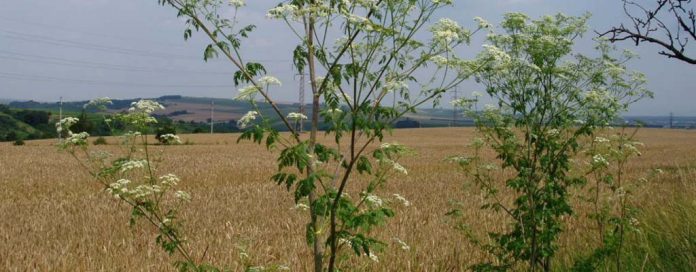When stands of established alfalfa get thinner over time weeds become a problem.
The presence of poisonous weeds are of greatest concern in established alfalfa.
Weeds poisonous to cattle that may show up in old alfalfa fields include curly dock, cressleaf groundsel, poison hemlock, redroot pigweed, horsenettle and eastern black nightshade.
Tall and smallflower buttercup may also be present, but they are not poisonous in dried hay. Of these species cressleaf groundsel and poison hemlock are the most poisonous.
Cressleaf
Cressleaf groundsel is becoming more prevalent across Ohio. It will end up in an alfalfa field from a nearby corn or soybean when the seeds blow over to the alfalfa field.
Cressleaf groundsel is a winter annual meaning it germinated last fall and will flower in May to June, therefore, it is most often found in the first cutting, but can be found in the second cutting in some years.
Cressleaf groundsel in the rosette stage has rounded deeply lobed leaves with one larger lob at the tip of the leaf. The leaves are usually a purplish-green color.
Stems are hollow, grooved and purplish in color. There is no hair on the plant. The numerous flowers are yellow (both center and the outside petals).
Limited data is available on how to control this weed in alfalfa. Velpar and metribuzin applied as a dormant application in the fall should be effective.
Pursuit or Raptor applied in the fall may provide some control. Mixing 2,4-DB with the Pursuit and Raptor may improve control.
In Roundup Ready alfalfa apply glyphosate in the fall at 1.125 pounds acid equivalent per acre. If caught early remove plants by hand.
Hemlock
Poison hemlock is also becoming more prevalent around the state. This weed usually stays along field borders, fence rows and railroads, but can be found in fields at times, so determine if it is present.
Poison hemlock is a biennial meaning it germinates one year forming a rosette and then bolts and flowers in mid to late spring the next year.
Poison hemlock looks similar to wild carrot, so leaves are compound but lobes are larger. Leaves are two to three times larger than wild carrot.
The plant has no hair compared to wild carrot. Stems have purple spots and the plant has a musty odor.
None of the herbicides available for postemergence application to non-Roundup Ready alfalfa will control poison hemlock.
Only a spot treatment of glyphosate or hand weeding will control poison hemlock. Apply glyphosate at 1.125 pounds acid equivalent per acre in the fall to Roundup Ready alfalfa.
Curly dock
Curly dock is a simple perennial. Curly dock has long leaves with a wavy leaf margin.
There is an ochrea at the nodes. The ochrea is a clear colored structure that wraps around the stem at the node.
The seeds are pyramid-shaped and red in color. Curly dock seedlings can be controlled with Pursuit.
Metribuzin, Sinbar, Tripzin ZC, and Velpar applied as a dormant application and Raptor and 2,4-DB applied before first cutting will suppress curly dock.
Apply glyphosate to plants in the fall at 1.5 pounds acid equivalent per acre. For small patches consider spot spraying with a high rate of glyphosate or digging out the plant. If digging, you must get most of the root or it will grow back.
Pigweed
Redroot pigweed is a summer annual. It has ovate leaves.
Stems and petioles are hairy and the base of the plant is usually red in color. The seed branches are short and thick on the end of stems.
Redroot pigweed can be controlled with Aim, Butyrac, Chateau (preemergence only), metribuzin, paraquat, Prowl H2O (preemergence only), Pursuit, Raptor, and metribuzin, Sinbar, Tripzin ZC and Velpar applied when dormant.
Apply glyphosate at 0.75 pounds acid equivalent in Roundup Ready alfalfa.
Horsenettle
Horsenettle is a creeping perennial. Horsenettle has a somewhat triangular leaf with shallow large rounded lobes.
The stem and the mid-rib on the bottom side of the leaf have large sharp spines.
The berries are about the diameter of a dime and are yellow in color at maturity.
None of the available herbicides for alfalfa will control horsenettle, except glyphosate. Glyphosate can be used as a spot treatment in non-GMO alfalfa or in Roundup Ready alfalfa.
Apply the glyphosate in the second application at 1.5 pounds acid equivalent per acre.
Nightshade
Eastern black nightshade is a summer annual. It has triangular-shaped leaves with the underside of the leaf being purple.
Pursuit and Raptor will control eastern black nightshade.













